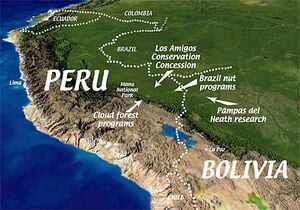
The Amazon Conservation Association (ACA) is a 501 ©3 nonprofit organization dedicated to conserving the natural landscape, and helping local communities thrive through the use of innovative tools and projects. This association is currently actively supporting populations in Peru and Bolivia but ACA has a variety of programs that they have developed or are developing to help an array of regions. According to Amazon Conservation Association's 2009 annual report, "ACA focuses on scientific research, the direct protection of critical habitats, sustainable use of natural resources, and environmental education and training for local stakeholders."[2]
History[edit | edit source]
In 1999 the Brazil nut project, which was to help Brazil nut harvesters have sustainable lifestyles and conserve the rain-forest, was the initiation of what is now known as ACA. Later that year in December 1999 Adrian Forsyth and Enrique Ortiz founded the Amazon Conservation Association. Since its initiation ACA has built a team of scientific researchers that help with its conservation efforts and teach rural communities about sustainable living. Over a decade ACA has developed a model known as Conservation Concessions that according to their 2009 annual report is "…a substantial portion of the land is publicly owned. Conservation concessions entrust long-term protection of publicly-owned land to non-profit institutions in exchange for investments in conservation and sustainable development. This allows private organizations such as ACA to assist the Peruvian government in achieving national biodiversity conservation goals."[3]
Mission[edit | edit source]
"Our Mission is to conserve the biological diversity of the Amazon."[4]
Brazil Nut Program[edit | edit source]
Brazil nuts come from trees that are found in South America; in Brazil it is illegal to cut down these trees down.[5] The Brazil nut tree has been proven to produce more seeds when in a "primary forest" condition; meaning that they are not grown in a plantation but naturally in the rain-forest. The nut helps bring in revenue for the harvesters and nearly 20,000 tons of Brazil nuts are harvested per year. The Brazil nut program was created to both protect the rain-forest environment and the livelihoods of the Brazil nut harvesters.[6]
This program has help generate income for the local harvesters and according to ACA it has supported over 500 Brazil nut harvesters.[7] In Peru ACA has established 474 family-run concessions and has also been able to protect many acres of the rain-forest through the creation of this program[8]
Other Programs[edit | edit source]
- Los Amigos Conservation Concession
- The Los Amigos Biological Station – CICRA
- Wayqecha Cloud Forest Biological Station
- Haramba Queros Wachiperi Conservation Concession
- Villa Carmen Campus for Conservation Economies and Biological Station
- Conserving the Pampas del Heath, Bolivia
References[edit | edit source]
- ↑ http://geogdata.csun.edu/world atlas/
- ↑ http://web.archive.org/web/20121207064416/http://www.amazonconservation.org:80/pdf/aca-annual-report.pdf
- ↑ http://web.archive.org/web/20121207064416/http://www.amazonconservation.org:80/pdf/aca-annual-report.pdf
- ↑ http://www.amazonconservation.org/about/index.html
- ↑ http://en.wikipedia.org/wiki/Brazil_nut
- ↑ http://en.wikipedia.org/wiki/Brazil_nut
- ↑ http://web.archive.org/web/20121207064416/http://www.amazonconservation.org:80/pdf/aca-annual-report.pdf
- ↑ http://web.archive.org/web/20121207064416/http://www.amazonconservation.org:80/pdf/aca-annual-report.pdf



